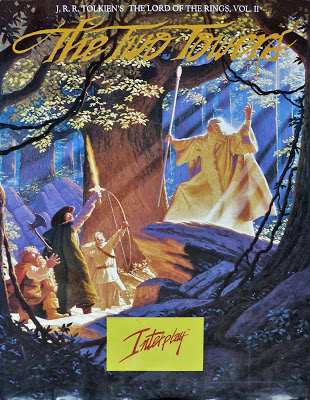From The CRPG Addict
Difficulty: Easy (2/5)
Final Rating: (to come later)
Ranking at time of posting: (to come later)
Summary:
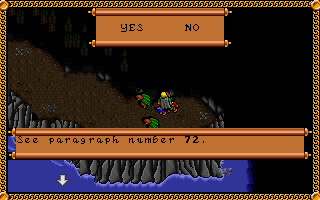 |
| Offering an option to execute Gollum took some guts. |
The problem with using existing plots is that either the player is on a railroad towards a predetermined destination, or he’s jarred by the detours. Perhaps the only way to do it well is to allow such detours (as Interplay did here) and then give it to a player who doesn’t care much about the original (e.g., me). In that sense, the game world worked out very well. Before we get into a litany of complaints, we have to at least admire the flexibility of the plot, plus the game’s ability to introduce side quests that work thematically with the main plot points. It was a strength of Vol. I as well.
The game fails, on the other hand, in just about every possible way as an RPG. There is no experience or leveling. Character development occurs through the occasional increase in attributes and the occasional acquisition of skills as a reward for exploration or quest-solving. None of these improvements mean anything because, first, combat is so easy that your characters don’t need to improve to beat the game, and second, every party starts with all the skills they need spread out among the characters. Inventory upgrades are scarce and essentially unnecessary for the same reasons. Combat couldn’t be more boring, and there’s essentially no magic system: “spells” are keywords that solve puzzles, more like inventory items.
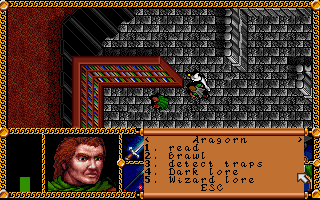 |
| Very late in the game, Aragorn can learn skills he won’t need for the rest of the game. |
Even worse is the way that it undercuts nonlinear exploration and optional encounters, essentially its only stretjg. While many of the side-quests and chance encounters are interesting, hardly any of them offer anything material to the characters. In fact, every time you stop to check out an unexplored area or building, you run the risk of some extra combats that leave the party weakened for the required encounters. This is related to the game’s absurd healing system, by which characters are only fully healed at a few plot intervals, with meals and Athelas curing just a few hit points in between.
Now, it turns out that I missed a lot of side quests, mostly towards the end. The open world is nice, but the game only gives you any directions along the main quest path. I never returned to Dunland, and thus missed the side adventures there. Ithilien had at least three side quests that Frodo and his party didn’t do, including a crypt, a Haradrim deserter who will join the party, and recovering the eye of the statue. If I’d gone another way in the Morgul Vale, I would have met Radagast. Aragorn missed the entire “Glittering Caves” sub-area, which culminated in a fight with a dragon and would have given him some powerful gloves. I still don’t know what I did wrong here. I did find the way to the Glittering Caves, but I somehow missed the transition to the multiple levels that the hint guide says exist. I guess I was supposed to return after the Battle of Helm’s Deep, but that would have meant embarking on a lengthy side-quest while on the threshold of victory for the game at large.
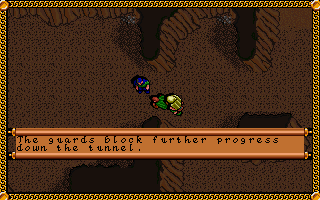 |
| I’m not sure how I was supposed to get past this. |
It’s also possible that I missed some of these side quests because of another problem: the interface. There are parts that aren’t so bad. The top-down perspective, the commands, and the auto-map all basically work, and I like the way you can make the interface go away and use the full screen for just exploration. What sucks is the approach to triggering encounters. You don’t see an NPC or group of enemies in the corner of your exploration window. No, they just suddenly pop up because you’ve happened to walk on the right set of pixels or brushed up against the right object. There’s very little correspondence between visual cues on screen and the appearance of encounter options. Sometimes, you see chests but walking up to them and bumping into them does nothing. Other times, you’re in a blank room, and you’re told about items and people that aren’t on the screen at all.
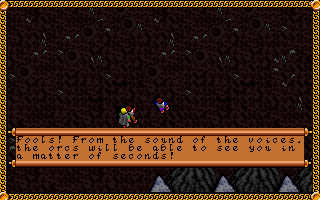 |
| Note that there are no orcs anywhere on this screen. |
Finally, we have the matter of pacing. It’s like the game itself has no idea what’s going to come next. The battle of Helm’s Deep involves six combats in a row, in two sets of three, with only a little bit of healing offered between the sets. After this epic battle, the party can rest and get fully healed, then (apparently) go off an find some magic gauntlets, when there’s only one more (easy) combat remaining in the game. On Frodo and Sam’s side, late in the game they have to figure out how to cut through Shelob’s web. The option I chose (use the Star Ruby) causes the hobbits to get burned a little bit, which would suck–except that the endgame happens five seconds later. Why bother to attach a penalty to the choice?
And while we’re talking about pacing, it’s important to remember how all the erratic cutting between parties makes it hard to keep track of what any one party is doing. I completely missed an opportunity to recover Anduril because the game lurched to a different party when I was on that quest, and by the time it took me back to Aragorn, it was shouting that Helm’s Deep was nigh.
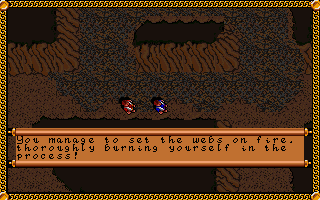 |
| Making the least-optimal choice hardly matters when the game is over at the next intersection. |
Lord of the Rings, Vol. I had a lot of these problems (except the last one), and it ended up with a relatively-high 49 on the GIMLET. Before we rate this one, it’s worth thinking about some of the differences. One is size. Vol. I is quite a bit bigger. Although Vol. II is good in this regard, Vol. I offered more opportunities for side quests, inventory acquisition, character development, healing, and general exploration. Pacing issues were caused as much by the player as by the plot.
Vol. I gave you a lot less direction on what to do next. There was a general sense that you had to keep moving east, but you weren’t constantly getting title cards explicitly explaining the next step of the quest. For that reason, NPCs and the dialogue system took on a much greater importance. Here, although you can feed NPCs a variety of keywords, they mostly just tell you what the game has already told you in long paragraphs. You never really need them for any clues.
NPCs themselves were more memorable. They had personalities, agendas, side quests, and even a couple of betrayals. Vol. II only marginally developed any of that. There was a poor economy in Vol. I, but Vol. II had no place to spend money at all despite showing that the characters had it. Also keenly felt is the loss of nice graphical (or animated, in the remake) cut scenes between major areas.
Both games do reasonably well in the area of encounters. I’ve always liked the way Interplay games (including Wasteland and Dragon Wars) require you to read clues and then figure out the right skills to directly employ. Sometimes, items can substitute for skills. But Vol. I‘s encounters of this nature were less obvious and a little less generous in the variety of things that would work. You couldn’t ignore options to improve skills or acquire quest objects. In Vol. II, you can pretty much just walk from beginning to end, knowing that your starting characters have whatever they need.
The rest might just be a matter of bad memory. Recalling the first game, I feel like the graphics offered a little more detail, that encounters didn’t depend on hitting quite such a small set of pixels, that there was a little more character development, a slightly better inventory system, and so forth.
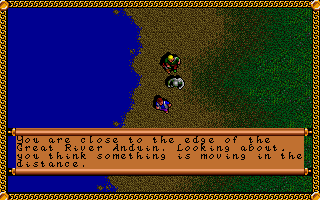 |
| The game tries to evoke the majesty of Middle Earth without showing much. |
Let’s see how they compare:
1. Game world. The Two Towers definitely makes good use of the Middle Earth setting. The backstory and lore section of the manual are thorough and interesting. It wasn’t until I read it that I finally understood some allusions from the films and the previous game, such as what “Numenor” refers to and what Gandalf actually is. While the game doesn’t do a lot to build on this setting, it certainly is in keeping with it. Score: 6.
2. Character creation and development. There’s no creation at all and only the slightest, near-invisible development. You mostly forget that the attributes even exist. Aragorn started with 70 dexterity, 28 strength, 33 endurance 75 luck, and 75 willpower, and he ended with 74, 28, 38, 79, and 77. Clearly, some development occurred, but never was I notified of any of these increases, and I really have no idea what caused them. The skills system would get more points if the game was a bit more balanced in how you acquire and use them. Score: 2.
3. NPC interaction. I always enjoy keyword-based dialogue systems, but here it’s mostly purposeless. When a title card has just told you that “Orcs have ravaged this village and its people are forlorn,” you don’t need six different NPCs saying, “Orcs destroyed us!” and “We have lost hope!” I did like the few NPCs who could join the parties. Without them, the game would have been forced to either avoid combat with the hobbit parties or make the hobbits uncharacteristically effective. Score: 5.
 |
| I’m sorry we didn’t see more of Eowen. |
4. Encounters and foes. Despite Tolkien featuring a large bestiary, you only really ever fight orcs and men in this game (aside from a few one-off battles). The only points I give her are for the non-combat encounters, which are frequent, require some puzzle-solving skill, and offer some role-playing opportunities. As mentioned, I don’t like the way that they appear, but that’s more of an interface issue. Score: 5.
5. Magic and combat. Combat features no tactics, no magic, no items to use. Just “attack” and select your preferred foe from a menu. The “magic system,” as such, is just the acquisition of some spell keywords that occasionally solve puzzle, but I only had to use one of these words once. (This is in contrast to the first game, where they were constantly required.) Score: 1.
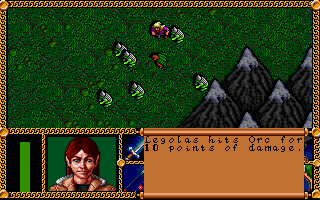 |
| The easy, boring combat system. |
6. Equipment. I found a few upgrades throughout the game: leather to chain, chain to magic armor, sword to magic sword, and so forth. It just didn’t feel like any of it did anything. Most of the items that burdened my inventory were quest items, and I found no use for a lot of them. Score: 2.
7. Economy. In contrast to the first game, there is none. The game keeps track of a “silver” statistic for each character for no reason. Score: 0.
8. Quests. Perhaps the strongest point. Each party has a clear set of main quests, an equal number of side quests, and even a few options about how to complete them. I enjoyed the side quests most because with them, I was exploring Middle Earth rather than just hitting a series of determined locations and plot points in a row. Score: 5.
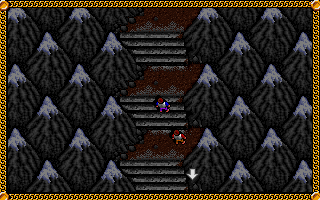 |
| The staircase to Cirith Ungol hardly seems hidden, tight, steep, or foreboding, especially with the silly “mountains” on either side. |
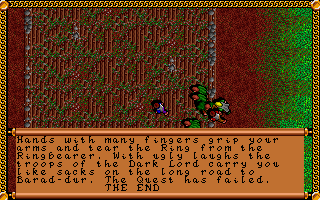 |
| I did like some of the “instant deaths.” |
 |
| “. . . no one.” |
Unlike Dragon Wars, which despite its initial disappointing commercial performance has gone on to attain a cult-classic status among hardcore CRPG fans, the reputations of the two Interplay Lord of the Rings games have never been rehabilitated. Indeed, to a large extent the games have simply been forgotten, bizarre though that situation reads given their lineage in terms of both license and developer. Being neither truly, comprehensively bad games nor truly good ones, they fall into a middle ground of unmemorable mediocrity. In response to their poor reception by a changing marketplace, Interplay would all but abandon CRPGs for the next several years.
Original URL: http://crpgaddict.blogspot.com/2019/03/lord-of-rings-vol-ii-two-towers-summary.html

